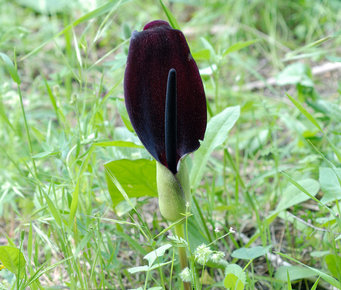Deceitful lily fools flies
Solomon’s Lily imitates a yeasty odor to lure vinegar flies into a trap
Scientists from the Max Planck Institute for Chemical Ecology in Jena, Germany, have solved a case of fraud that has been pending for 40 million years. Arum palaestinum, also called the Solomon’s lily, attracts drosophilids (vinegar flies) as pollinators by emitting odor molecules that resemble those produced during alcoholic fermentation of rotting fruit initiated by yeast. The plant accomplishes the illusion of yeast simply by producing six chemicals that - together in a specific mix - create the impression of fermentation in the fly brain. The produced volatiles include two chemicals which are very rarely encountered in plants but are typical of wine and vinegar - actually byproducts of yeast activity. The scientists showed that the lily’s fragrance targets a deeply conserved neuronal pathway specifically tuned to yeast odors. Thus, the Solomon’s Lily is exploiting a million-year-old instinct in flies for its own purposes. (Current Biology, October 7, 2010)

The genus Drosophila - vinegar flies - consists of many species that feed on a variety of sources ranging from fruit to bacterial layers on certain tropical land crab species. For most drosophilids, yeast is the main food. Their antennae and antennal lobes, the first brain region that receives input from the olfactory sensory neurons, are accordingly specialized in perceiving odor molecules typically emitted by growing yeast. The smallest concentrations are sufficient to lead vinegar flies to their food source.
Many flowering plants depend on insect pollinators; they ensure that offspring are produced and guarantee genetic variability. Flowers use colorful petals and odor bouquets to attract them. Although often pollination service is rewarded with sweet nectar, Arum palaestinum tricks its pollinators. The plant, also called the Solomon’s Lily, produces an odor in its violet-black flowers that to a human nose is most similar to a fruity wine. It was obvious that the plant attracts pollinators with this odor, namely vinegar flies. But unlike other flowers, Arum palaestinum does not give a reward in form of nectar; in fact, flies are trapped in the flower overnight and not released until the next day.

Drosophila melanogaster is also deceived
Johannes Stökl and Marcus Stensmyr have not only collected and analyzed this odor, but also examined and identified the drosophilid species trapped in the plant. Together with behavioral biologist Markus Knaden, they studied the reactions of the insects to different odor molecules. In addition, their colleagues Silke Sachse and Antonia Strutz performed neurophysiological measurements on the flies. The studies provided interesting results: Arum palaestinum attracts an average of 140 flies per plant, mainly flies from eight different Drosophila species including the well-known laboratory work horse and kitchen nuisance Drosophila melanogaster. Fourteen chemical compounds that caused the flies’ antennae to respond were emitted by the plant. To test these reactions, Johannes Stökl measured and recorded the action potentials in the antennae of the insects. Chemical analysis of the odor compounds released by the plants showed that most were esters.
"The most remarkable odors of the bouquet were 2,3-butandiol acetate and acetoin acetate," explains Marcus Stensmyr, leader of the study. Interestingly, these molecules are not contained in the bouquets of flowering plants, but are characteristic of vinegar, especially aceto balsamico, and wine - or, in other words: yeast fermentation products. Those two compounds as well as four more that also emerge during yeast fermentation showed the strongest and most stable signals in the electroantennograms.

Two receptors, one fraud
In neurophysiological experiments, the flies were exposed to natural odor bouquets, such as the smells of rotting peaches or bananas as well as Lambrusco (red wine) and aceto balsamico (vinegar). The respective electroantennograms strikingly resembled the recordings from flies that had been exposed to the lily odor, suggesting that to a fly, these odors have a most similar smell.
"The flies are unable to distinguish the lily from rotting fruit - they are deceived by the lily because it imitates the yeasty odor although it does not offer yeast as food," says Johannes Stökl. The insects' involuntary pollination service is not even rewarded; in fact, just the opposite is true: the flies are trapped in the flower until it opens again after 24 hours - and they stay hungry.
Using transgenic flies expressing a calcium sensitive activity reporter, Silke Sachse, leader of the Functional Imaging Group, and her PhD student Antonia Strutz, were able to trace the activity of the yeast odor stimulants in the brains of the flies. This functional imaging technology helped to demonstrate that eleven different odorant receptors were activated. Because different drosophilid species were deceived by the Solomon’s Lily, it seemed likely that evolutionary ancient odorant receptors were among the activated ones, and this turned out to be the case. "The sequence of two of the odorant receptors, namely Or42b and Or92a, is highly conserved. These genes are likely to have a critical function as "yeast detectors" across most, if not all drosophilid flies," explains Bill Hansson, director at the institute.
Is keeping a Solomon’s lily now the ultimate solution to rid your kitchen of flies? "Well, since they only flower once per year, and then only for a few hours, a cup of vinegar is still a better option. However, during the hours it flowers, I can assure you there will be no flies left in your kitchen!" says Marcus Stensmyr.


